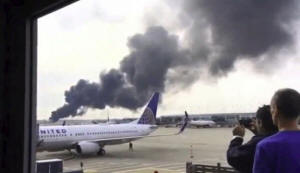|
U.S. blames American Airlines fire on
engine failure
 Send a link to a friend
Send a link to a friend
 [November 05, 2016]
WASHINGTON/SEATTLE (Reuters) - A
fire on an American Airlines passenger plane as it was taking off from
Chicago's O'Hare International Airport last week was sparked when the
right engine broke apart, the U.S. National Transportation Safety Board
said on Friday. The investigative update shed new light on a rare
"uncontained" engine failure, in which pieces escaped the engine
housing, that has been the talk of aviation circles since the incident
on Oct. 28. [November 05, 2016]
WASHINGTON/SEATTLE (Reuters) - A
fire on an American Airlines passenger plane as it was taking off from
Chicago's O'Hare International Airport last week was sparked when the
right engine broke apart, the U.S. National Transportation Safety Board
said on Friday. The investigative update shed new light on a rare
"uncontained" engine failure, in which pieces escaped the engine
housing, that has been the talk of aviation circles since the incident
on Oct. 28.
Pilots applied brakes to the Boeing 767-300 jetliner bound for Miami and
aborted the takeoff of Flight 383. The engine failure caused a fuel leak
that resulted in a fire under the right wing. The incident led to
emergency evacuation of 161 passengers and nine crew, but no serious
injuries.
The plane, built in 2003, experienced the failure about 6,550 feet
(2,000 meters) after beginning its take-off and came to a full stop at
9,225 feet (2,800 meters), about 27 seconds after the engine failure,
the NTSB said in an interim report.
Investigators looking for what caused the General Electric CF6-80 engine
to fail are focusing on a high pressure turbine disk that broke apart.
One piece hit a UPS warehouse facility, about 3,000 feet (900 meters)
from the runway, after slicing through a portion of the wing and
traveling over the fuselage. The majority of the disk was recovered, and
during laboratory inspection showed features consistent with fatigue
cracking, the NTSB said.

The disk had gone through 10,984 cycles, or take-offs and landings, and
had a life limit of 15,000 cycles. Review of the engine maintenance and
manufacturing records and processes was continuing, the NTSB said,
adding that additional examinations of the disk would focus on the
cracking.
[to top of second column] |

Smoke rises after an American Airlines jet (background) blew a tire,
sparking a fire and prompting the pilot to abort takeoff before
passengers were evacuated from the plane via emergency chute, at
O'Hare International Airport in Chicago, Illinois,
U.S., in this still image taken from video October 28, 2016.
Courtesy of Robocast.com/Handout via REUTERS.

GE said the engine was manufactured in 1998. The failed disk was
made of Inconel 718, an alloy used in aviation for decades, GE said.
The CF6 engine is used on current Boeing 767 freighters and the
KC-46 tanker used to refuel military planes in flight.
Uncontained aircraft engine failures are rare. GE said it had not
suffered an engine failure caused by a problem with the Inconel 718
disk in more than 30 years. The CF6-80C2 has been in service for
more than 30 years and has an in-flight shutdown rate of 0.004
percent over 400 million hours of flight.
The rotating disk "operates in one of the most harsh environments of
a jet engine, especially at aircraft take-off," GE said in a
statement.
American Airlines declined to comment.
The fire prompted 130 delays of departing flights and 170 inbound
flights within two hours, according to flight-tracking website
FlightAware.com.
(Additional reporting Jeffrey Dastin in New York; Editing by Frances
Kerry and Dan Grebler)
[© 2016 Thomson Reuters. All rights
reserved.]
Copyright 2016 Reuters. All rights reserved. This material may not be published,
broadcast, rewritten or redistributed. |